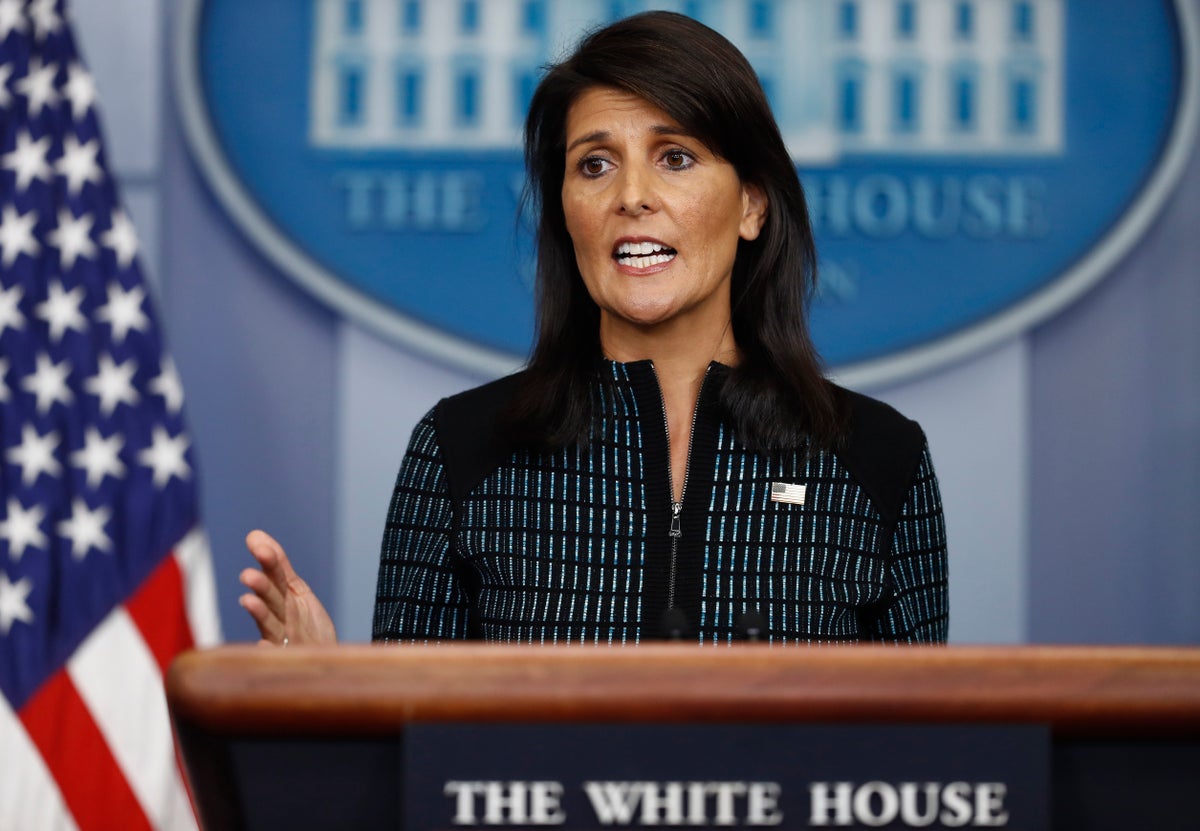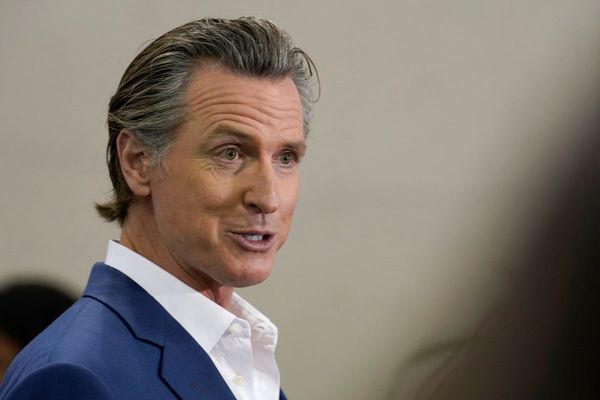
Former South Carolina Governor Nikki Haley had a unique journey from the governor’s mansion in Columbia to the 2024 primary field, which she entered on Tuesday as only the second prominent Republican, behind Donald Trump, in the field.
Once beloved by the GOP’s moderate wing and now painted with the same “sellout” label that those same NeverTrumpers stuck to Marco Rubio, Lindsey Graham and others, the nation’s second-most prominent Indian-American politician (behind VP Kamala Harris) is hoping that the GOP establishment’s desire to move on from Trumpism will be the wind in her sails that carries her campaign to the nomination.
On Tuesday, she joined the race officially, albeit in a prerecorded message. Declining to host a flashy launch party like the one Donald Trump attempted last year, Ms Haley opted instead for a muted video plea for Republicans to embrace a new generation of leaders: code words in Washington for an anti-incumbency bent.
But as many analysts and experts have pointed out in the hours and days since it first became clear that an announcement was imminent, it’s unclear where Ms Haley goes from here. She continues to poll in the single digits in every single reliable survey, all of which include other GOP rivals like Mr Trump and Ron DeSantis, the governor of Florida who is also thought to be harbouring national ambitions.
As one potential 2024 rival, John Bolton, pointed out, Ms Haley’s actual realisable goal may be the vice presidency, a position that would likely be wide open under either Mr Trump or any insurgent anti-Trump alternative who could theoretically dethrone him.
With all of that in mind, let’s take a look at how Nikki Haley got here, and how the thin line she has threaded between the pro- and anti-Trump wings of the party could leave her high and dry come the Iowa caucus next year:
January 2016-November 2016: Haley joins the doomed anti-Trump crusade
At the time one of the most well-respected GOP governors in the country, Nikki Haley was expected to be a major player in the 2016 Republican nomination contest. Able to work with Democrats on issues like taking down the confederate flag from South Carolina’s statehouse in the aftermath of a racist massacre, Ms Haley was seen by many before the launch of Donald Trump’s campaign as would-be kingmaker. She joined Marco Rubio’s campaign, denouncing Mr Trump and vowing to not “stop fight[ing]” the man who had come from nowhere to achieve total dominance of her party.
Instead, like every other Republican, she watched her chosen champion swatted away by Mr Trump like a mere nuisance. By the general election, she was an afterthought, refusing even to take a firm stand one way or the other about the shocking Access Hollywood tape uncovered revealing Mr Trump making vile, sexist comments about women.
November 2016: If you can’t beat ‘em, join ‘em
Days after Mr Trump won the 2016 election, he shocked the media yet again by selecting Ms Haley, his onetime critic, for the powerful role of UN ambassador.
Even more surprising at the time (though less so now, given the GOP’s total capitulation to Mr Trump), she agreed. With a full year left in her term as governor of South Carolina, Ms Haley announced her resignation and plans to join the Trump administration. Anti-Trump conservatives were disgusted, while Trump supporters viewed the moment as yet one more example of Mr Trump’s Republican rivals bending the knee in defeat.
March 2017: Haley takes first swipe at new boss
After joining Trumpworld, Ms Haley spends two years in the administration before her eventual resignation. Within just a few weeks of being sworn in, however, she was back in the headlines criticising her then-boss, whom she differed with over his plan to ban Muslims from entering the United States. Ms Haley calls the plan “un-American”.
December 2017: Another jab from Haley
Speaking to reporters for the first time about the Access Hollywood tape that she ignored in 2016, Ms Haley breaks with the White House and says that women who have accused her boss of sexual misconduct should be heard.
“Women who accuse anyone should be heard. They should be heard and they should be dealt with, and I think we heard them prior to the election,” she said. “I think any woman who has felt violated or felt mistreated in any way, they have every right to speak up.”
She added that Americans could decide for themselves if they believed Mr Trump or not.
December 2018: Haley leaves office
In late 2018, Ms Haley announced that she would step down as UN ambassador after two years on the job, with her resignation taking effect at the end of the year.
It came after Mr Trump’s team faced aggressive media scrutiny and at the time, Ms Haley defended the administration’s record, even calling Mr Trump a “friend”.
6 January 2021
As Mr Trump’s supporters stormed the US Capitol in an attempt to harm US lawmakers and prevent the certification of the 2020 election results, Ms Haley was one of many Republicans who denounced the violence and criticised the president.
"We need to acknowledge he let us down. He went down a path he shouldn't have, and we shouldn't have followed him, and we shouldn't have listened to him. And we can't let that ever happen again,” she said at the time.
February 2021: Haley comes crawling back
Within a month of the January 6 attack on Congress, Nikki Haley was already looking for a way back in Trumpworld.
News reports indicated that she had tried and failed to secure a sit-down meeting with her former boss at Mar-a-Lago. And in a Wall Street Journal op-ed, Ms Haley appeared to show contrition for turning her back on Mr Trump after his supporters attacked the seat of US government.
“Most of Mr. Trump's major policies were outstanding and made America stronger, safer and more prosperous. Many of his actions since the election were wrong and will be judged harshly by history...I will gladly defend the bulk of the Trump record and his determination to shake up the corrupt status quo in Washington,” she wrote at the time.
April 2021: Haley makes her plans official ... sort of
Just a few more short months later, Ms Haley made it official, declaring that she would support Donald Trump for president in 2024 and stating that she would not run if her old boss ran again. Oops.
July 2022: Maybe she will run?
Just a year after she ruled out the possibility of running for office should Mr Trump run again, Ms Haley was publicly hinting that she in fact would be a challenger for the 2024 nomination.
As dispatches from Mar-a-Lago circulated rumours throughout 2022 of Mr Trump’s imminent plans to announce his candidacy, Ms Haley travelled to the early caucus state of Iowa and dropped several hints about her national ambitions.
Speaking about the 2015 nuclear accord signed between the US and Iran at a July 2022 event in Sioux Center, Iowa, she quipped: "If this president signs any sort of [Iran nuclear] deal, I'll make you a promise: the next president will shred it on her first day in office.”
14 February, 2023: Haley joins the race
Finally, we reach the culmination of at least the last six years of Ms Haley’s professional career: the launching of her bid for the presidency.
In a short announcment video, Ms Haley doesn’t mention her former boss at all, despite him being the only other candidate — and the frontrunner — currently seeking the GOP nomination.
Instead, she calls for a new generation of leaders, while snidely remarking that her party, very much including Donald Trump, lost the popular vote seven of the last eight presidential elections.
Where Ms Haley goes from here is uncertain. Her campaign could very well burn out before the Iowa caucus in 2024, or she could find some spark that ignites a passion in the GOP base and begins an upward trajectory that lands here somewhere in a new Republican administration.
One thing remains likely, however: no matter what Donald Trump says or does, Ms Haley’s relationship with her former boss will be one defined as much by necessity as much as its unpredictability.







